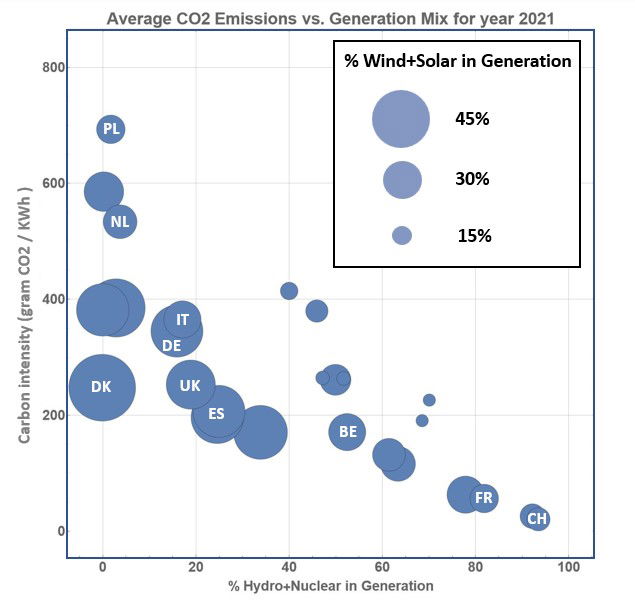Climate Change and Electricity Generation
Website presenting studies on:
Electricity Generation
Electricity Technologies
Climate Change
(Links to section in top bar)
Some Highlights of website
Content of Electricity Generation Section
The section Electricity Generation contains analyses of electricity generation data in order to illustrate which mixes of electricity generation technologies give the lowest levels of carbon dioxide emissions. Reducing the carbon dioxide emissions into the atmosphere is essential to rebalance the heat arriving and leaving the earth caused by the greenhouse effect and so avoid disastrous global warming.
Data is presented from numerous countries around the world but goes into most detail for countries in the European Union. The analyses explore wind power and solar power data to demonstrate the intermittency due to weather fluctuation is nearly everywhere compensated by fossil fuel generation. The data shows that countries with large amounts of nuclear and hydro generation have the lowest carbon emissions and countries with high amounts of wind and solar usually have relatively high emissions.
A list of the full content in this section together with some details of the data analysis can be found at: Overview of website contents. Below, some example plots with links for details are given.
Carbon Emissions

The plot demonstrates that the Carbon Intensity of emissions in electricity generation is lowest for countries with large fractions of hydroelectric and nuclear. Countries with large fraction of wind and solar generation have medium carbon emissions because weather fluctuations necessitate back-up with fossil fuel.
Details at: CO2 Emissions in European Countries
Wind Intermittency
Wind power production is extremely variable due to weather fluctuations. To satisfy consumer demand during low wind periods, fossil fuel generation must be increased. Further, because weather patterns are large scale in Europe the wind variations are often similar in in close-by countries.
Details at: Wind Intermittency Problem
Balancing Demand
Denmark has 50% of wind+solar energy in the local generation mix. In order to meet consumer demand for electricity in the periods with low wind, back-up is provided with fossil fuel generation and imports.
Details at: Denmark as example of large wind capacity
The pages in the Wind Intermittency section, explain the problem and present conclusive data explaining the nature of the problem and the magnitude. The conclusions can be summarized as:
- Wind fluctuations in a single country span the range from 5% to 80% of installed capacity because of weather coherence over large areas.
- Similar fluctuations exist in adjacent countries on the 1- 5 day timescale.
- Storage of sufficient power to cover 3 days of wind power off is not possible with existing technology, at least in countries with large wind capacity and low hydro capacity.
- To compensate for these fluctuation, fossil fuel capacity of magnitude roughly equal to the wind power capacity is needed.
- Import/exports can only help the situation in a particular country when adjacent countries have large hydro capacity or fossil fuel capacity available to provide the compensation.
Another limiting factor for wind power is the inflexibility to cover demand variations. The magnitude of these variations are presented in the pages of the Demand Variations section where its is shown that:
- Demand variations between summer nights and winter days are up to a factor 2 in some countries.
- In countries with little hydro generation capacity these variations are compensated for essential with variations of fossil fuel generation.
The evaluation of current carbon dioxide emissions show:
- Countries with > 20% wind+solar generation have typically 200-400 gCO2 equivalent/KWh.
- Countries with > 50% nuclear+hydro generation have < 200 gCO2 equivalent/KWh.